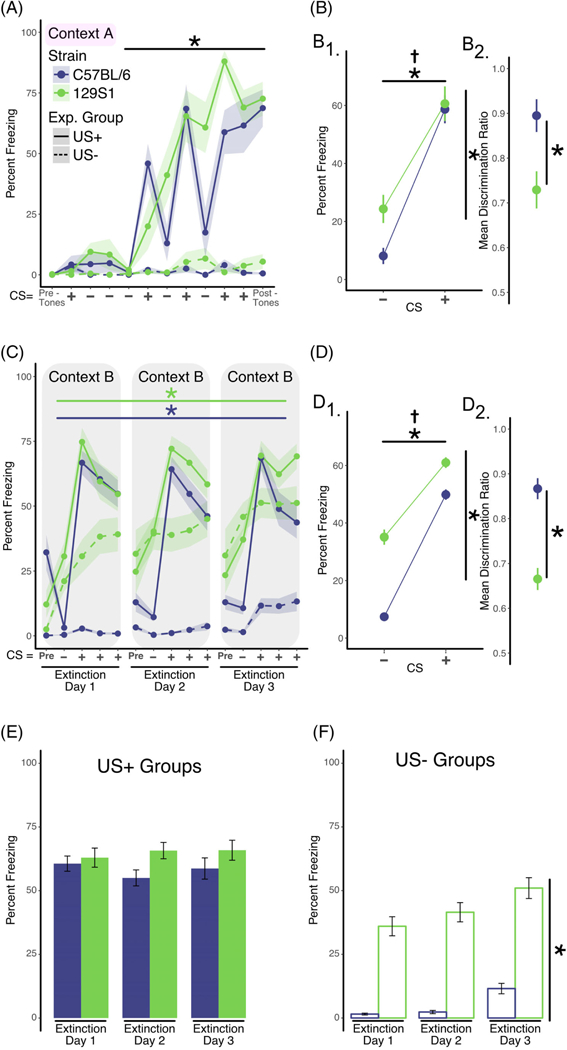FIGURE 3.

Delaying extinction training by 7 days does not impact extinction learning or discrimination of the CS+. A, Analysis of training data. Two separate groups of mice were used in this experiment. Mice in the US+ group (solid lines, C57BL/6 n = 8 [four males; four females], 129S1 n = 8 [four males; four females]) were exposed to discontinuous or pipped auditory stimuli that consisted of white noise (CS−; 200-ms white noise pips, delivered at 1 Hz for 25 seconds) or 4-kHz pure tone (200-ms pips, delivered at 1 Hz for 25 seconds) that co-terminated with a foot shock (CS+). Mice in the US-group (dashed lines, C57BL/6 n = 8,129S1 n = 8) received the identical auditory stimuli but did not receive the foot shocks. Mice in the US+ group exhibited increased freezing across the training session (repeated measures ANOVA; effect of training, P < .001) independent of strain. In the absence of shock, mice in the US-group did not exhibit significant levels of freezing. B, Analysis of discrimination learning during training. The mean percent freezing averaged across all CS+ presentations during training was significantly greater in both strains when compared with the mean freezing in response to the CS− presentations (B1, two-factor ANOVA; effect of CS, P < .0001). However, calculation of the discrimination ratio showed that C57BL/6 discriminates the CS+ and CS− better than 129S1 mice (B2, unpaired t test, P < .01). C, Analysis of within-session extinction learning. Seven days following training, mice in both groups were exposed to four CS− stimuli followed by 12 CS+ presentations (displayed in bins of four stimuli) in a new context (Context B) for 3 days (extinction days 1–3). Repeated exposure to the CS+ tone in the US+ group resulted in significant decreases in freezing within extinction sessions for both strains (using separate repeated measures ANOVA per strain; effect of bin, P < .01). D, Analysis of tone discrimination during extinction. Mice in both strains exhibited significantly more freezing when exposed to the CS+ tone (D1, two-factor ANOVA; effect of CS, P < .001). However, the C57BL/6 showed significantly better freezing discrimination to the CS+ compared with the 129S1 strain when the discrimination ratio was calculated (D2, unpaired t test; P < .0001). E, Analysis of extinction across days (US+ Group). Freezing across extinction days was analyzed by calculating the mean percent freezing for the three binned CS+ presentations for each of the three extinction days (solid line in panel C). No statistically significant reductions in freezing were observed for either C57BL/6 and 129S1 mice. F, Analysis of freezing in the US-group across days. Freezing in the US-group was calculated each day as the mean percent freezing measured during the CS+ tone presentations (dashed line in panel C). The 129S1 mice exhibited increased “freezing” across the 3 days of re-exposure to the CS+ tone compared with the C57BL/6 strain (two-factor ANOVA; effect of strain, P < .0001), in spite of the fact that they never received the foot shock. Data shown as sample mean with shaded region or bars representing the SE of the mean. Asterisk (*) denotes statistical significance for main effect of training (horizontal line) or strain (vertical line) and a dagger (†) for significant interaction between main effects. Data are presented as mean ± SEM
